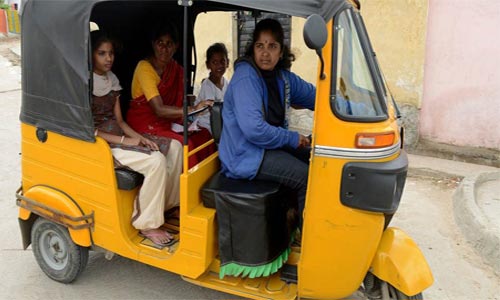When resources are limited, it is human capital that defines the sustainable development of a community, especially in the case of costly misallocation and underutilization, as is often the case in developing countries. Nowhere is this truer than in India, where the value of the current demographic dividend hinges on a grossly underutilized resource pool – the female workforce.
Despite rising education levels and a female literacy rate of 65%, only about a quarter of Indian women participate in the labor force. Increasing women’s workforce participation by a mere ten percentage points could add $700 billion to India’s GDP by 2025. And that requires removing one of the main obstacles to achieving this objective: broken transportation services.
Astha (name changed), a 35-year-old teacher working in the district headquarters of Jhunjhunu, in the state of Rajasthan, is one of the youngest teachers ever to be nominated for a promotion to school headmistress. But accepting the promotion meant transferring farther away from home. She took the new position, only to find the commute difficult and unsafe, as she left in the early hours of the morning, walking 1.5-2 kilometers every day. Two months into her new role, unable to depend on being escorted by family members to the bus depot daily, she gave up the job and returned to a lower position at the nearby school. Lack of reliable transportation led her to give up this opportunity.
According to the National Sample Survey Office, more than 60% of rural and urban households use buses as their main mode of public transportation, followed by auto-rickshaws, taxis, railways, and cycle rickshaws. While we have come a long way in reach and coverage when it comes to bus and rail networks, India’s door-to-door transportation network is still dispersed and unreliable. Unfortunately, working women are the most severely affected by inadequate service.
When safe and efficient public transit is unavailable, women typically settle for lower-paid jobs closer to home. This is reflected in the distance women travel for work in urban areas. In Bengaluru, for example, the average daily commute for women is just over a mile, while men travel twice as far for their jobs. In Delhi, 75% of women work within a three-mile radius of home, whereas 75% of men work within eight miles.
The biggest transportation roadblock for women in India lies in what planners call the first-last mile problem – getting to and from the station, a concern that Astha knows well. While this problem is a feature of any transportation network, in developing countries it adds significantly more time, cost, and safety constraints to every journey. In Delhi, for example, the first and last miles constitute 41% of the total time and 47% of the total cost of the trip.
Clearly, the consequences of the first-last mile challenge are profound – not only for women, but also for India’s economy. How, then, can planners improve transportation to get more women working?
There is only one persuasive answer: better auto-rickshaws. India has more three-wheeled vehicles than any other country, and every day, millions of people are whisked through narrow streets and congested traffic in these easy-to-maneuver carts. Yet Indian rickshaws have not evolved in the last 50 years to serve either the rider’s or the driver’s needs. They are poorly distributed, unsafe, and not future-ready. To solve women’s urban mobility challenges, we need a completely reimagined vehicle that is electric, shared, safe, and “smart.”
Indian women’s travel is characterized by “trip chaining.” They make shorter and more frequent trips than men, and their trips often involve more stops, to run errands, shop, pick up children from school, and so forth. This increases their dependency on first- and last-mile transportation. However, most rickshaws operating in India today are unorganized and ply only the busiest, most lucrative routes.
With the right innovations in technology and policy, we can bring order to the scattershot nature of India’s auto-rickshaw fleet and bridge the demand-supply gap. For example, ride-hailing apps and booking platforms could efficiently match rider demand with rickshaw supply, as would well-orchestrated feeder services to bus and rail networks. Policies that encourage ride sharing could multiply fleet capacity.
In terms of safety, it is necessary to consider both accidents and crime or harassment. For starters, nearly 40% of all accidents involving these vehicles cause them to topple. And a study in Delhi showed that 51% of women had faced some form of harassment while using public transport, and 42% while waiting for it.
We need innovations in accident-prevention systems and other technologies that would make such technologies a feature of low-cost three-wheelers. Technology can also help connect transportation nodes and vehicles to police and medical systems, substantially reducing the response times for emergency services.
Safety from crime, on the other hand, needs a connected, smart ecosystem with auto-rickshaws at its heart. Rickshaws equipped with GPS systems could enable passengers to share real-time location data with family or friends. A mandatory SOS alert system would give passengers and drivers a means to call for help, regardless of whether they were carrying a mobile phone. Government regulations already require panic buttons in taxis, public buses, and other public transport; requiring them for rickshaws is the natural next step.
Last but not least, we need these reimagined vehicles to be future-ready. Air pollution is a ticking bomb: 14 of the 15 cities with the world’s highest concentrations of fine particulate matter are in India, underscoring the urgency of switching to low-carbon, battery-powered vehicles.
When women can travel to work conveniently, choosing affordable transportation, without fear of harassment or abuse, India will have arrived. Talented women like Astha will never need to choose between a job they love and a commute they loathe. Indian women need affordable, safe, and reliable options to help them overcome the first-last mile problem. A reimagined rickshaw may be just the ticket.
Home » Opinion » Women, Work, and India’s Rickshaw Revolution
Women, Work, and India’s Rickshaw Revolution
| Kasturi GVL

